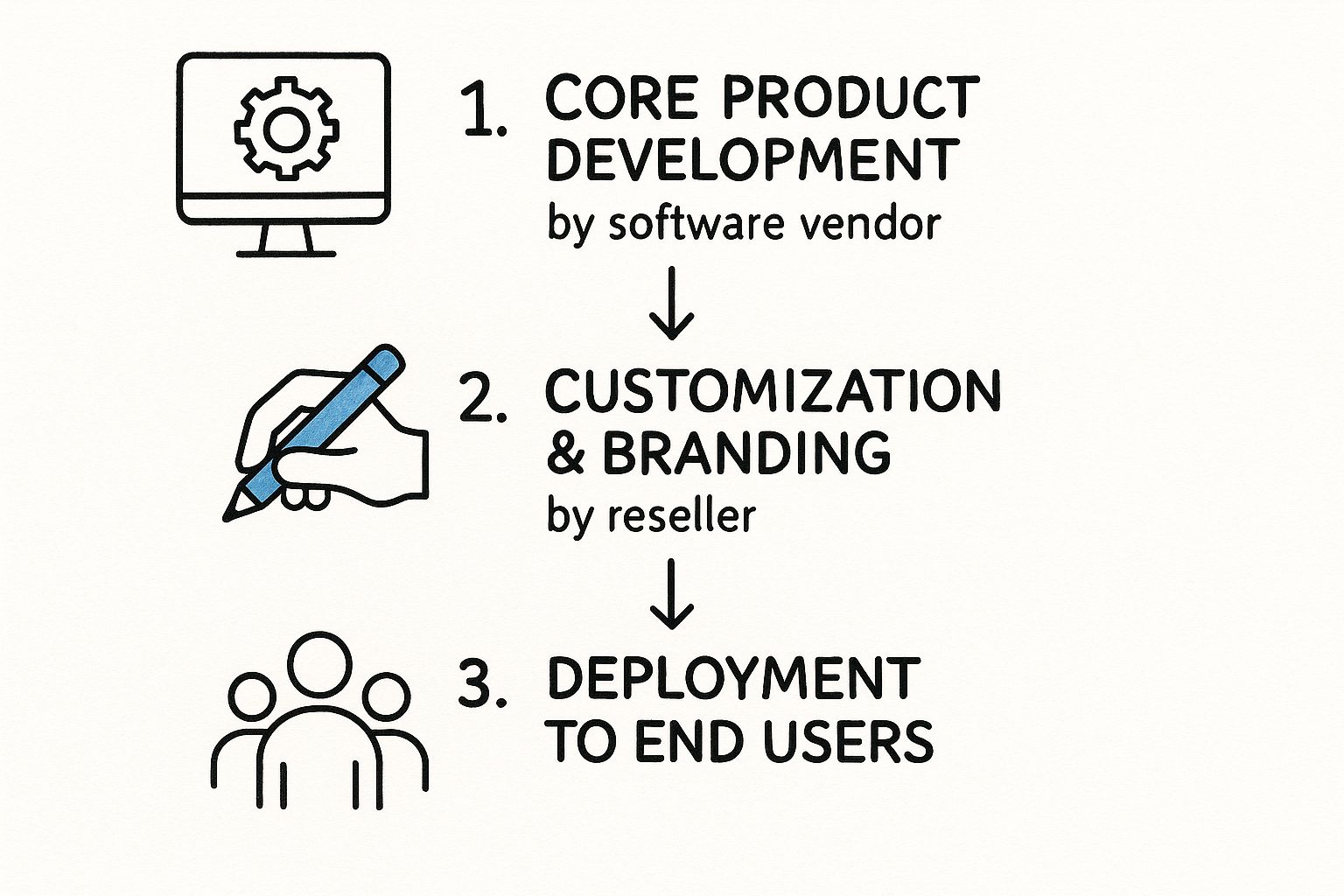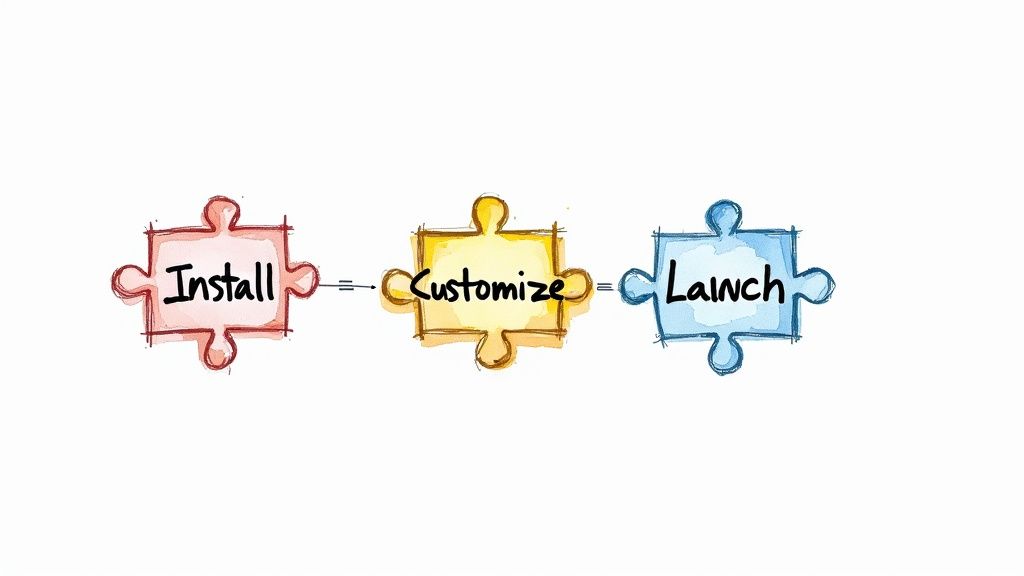August 8, 2025

Let's get straight to it: what is white label software?
Think of it like the generic store-brand products you see at the supermarket. A big, experienced food manufacturer produces a high-quality cereal, but instead of putting their own name on the box, they let the grocery store put its brand on it. You, the customer, get a great product at a good price, and the store gets to sell its "own" cereal without building a factory.
White label software works exactly the same way. A specialized tech company builds a fantastic, fully functional software platform. Then, your business can license that software, put your own logo and branding all over it, and sell it to your customers as if you built it from scratch.
This model lets you add a sophisticated, ready-made product to your offerings almost overnight—without spending the time, money, and resources on development. Instead of getting tangled up in coding, debugging, and server maintenance, you get to focus on what you're best at: growing your business and taking care of your clients.
For any business looking to expand its services, open up new revenue streams, or jump into a new market quickly, this approach is a total game-changer. It lets you compete with confidence right out of the gate.

To really get how this works, you need to know the key players. It's a partnership where everyone has a specific, vital role that benefits the others.
The whole setup is designed for mutual success. One company gets its product into more hands, and the other gets to launch a new offering in record time. This cooperative structure is what makes white labeling such a powerful growth strategy.
To break it down, here’s a look at who does what in the white label ecosystem.
Essentially, the provider handles all the complex technical heavy lifting behind the scenes. Your business steps in to handle the branding, marketing, sales, and customer relationships.
The white label market is absolutely booming worldwide, and not just for software. Businesses are jumping on this model because it helps them innovate faster, drastically cuts down their time-to-market, and keeps their customers sticking around longer. This trend has turned white label solutions into a key strategic move for companies trying to stay ahead in a tech-first world. You can dig deeper into the growth and future outlook of the white label market to see just how massive it’s become.
Key Takeaway: The whole idea behind white label software is about smart leverage. It’s a way for your business to use the expertise, time, and money already invested by a developer to put your own product on the map—fast. It’s a shortcut, but a very effective one.
So, how does a generic piece of technology become something that looks and feels like your company’s own custom-built software? The process is surprisingly straightforward—less of a technical maze and more of a structured partnership. It all starts with the white label provider, the company that has already done the heavy lifting of engineering, developing, and testing a powerful core platform.
This provider has created a stable, feature-rich application that is intentionally unbranded. Think of it as a beautifully prepared blank canvas, just waiting for an artist. In this scenario, your business is the artist. You purchase a license or subscription, which gives you access to this canvas. This is where the real magic begins.
Once you have access, you'll typically get a control panel or admin dashboard. This is your command center for making the software your own. From here, you can systematically apply your brand’s identity, making it completely unrecognizable as a third-party tool to your customers.
The main goal is to create a seamless experience, making the software look just like a solution you might have spent years and a fortune building from scratch. This usually involves a few key steps:
app.yourcompany.com).This simple infographic breaks down the journey from a core product to your finished, branded solution.

As you can see, it's a logical progression. The provider handles the complex technical work, freeing you up to focus on branding and getting your new product to market.
While the front-end branding is what your users will see and admire, the real genius of white label software is its underlying architecture. Two key concepts make this model work so smoothly and securely for everyone involved.
The first is multi-tenant architecture. Think of it like a modern apartment building. The building itself is the core software, and each reseller (or "tenant") gets their own secure, private unit. Even though everyone shares the same foundation, each tenant's data, customizations, and users are completely walled off from their neighbors. This is what keeps your business and customer information safe and sound.
A robust multi-tenant architecture is non-negotiable. It’s the guarantee that one company’s activity, data, or user traffic will never interfere with another's, ensuring stability and security for everyone on the platform.
The second critical piece of the puzzle is the Application Programming Interface (API). An API acts as a translator, allowing the white label software to "talk" to the other tools you already rely on. This lets you weave the new software directly into your existing workflow. For example, you could use an API to connect your white-labeled CRM to your email marketing platform, automatically syncing new contacts without any manual effort.
With the branding complete and any integrations set up, the final step is to go live. You are now free to market and sell the software to your customers under your own brand, at your own price. All the while, the original provider remains completely invisible, working in the background to handle server maintenance, security updates, and bug fixes.
This streamlined process shows that getting a handle on what is white label software is really about seeing it as a smart, manageable partnership. It’s not a technical headache; it's a strategic collaboration designed for speed and efficiency, letting you launch a powerful new offering with far less risk and in a fraction of the time.
Thinking about white labeling? It's more than just a clever shortcut. When done right, it's a strategic powerhouse that can completely change the game for your business, giving you an edge in speed and agility that’s tough to build from scratch.
Imagine being able to launch a polished, feature-rich service in a matter of weeks, not years. By slapping your brand on a product that’s already been built and tested, you get to skip the time-consuming and expensive process of starting from zero. That speed to market is a massive competitive advantage.

When you offer a sophisticated software tool under your own name, something powerful happens: you instantly look like a bigger deal. Clients see you providing a professional, high-value solution, and their trust in your expertise grows. You're no longer just a service provider; you're seen as an innovative leader in your field.
Take a marketing agency, for example. It could go from simply managing client campaigns to offering a "proprietary" analytics dashboard. That small shift completely changes how clients see the agency, cementing its role as a vital partner. This isn't just about perception—a stronger brand can charge more and attract better clients, directly boosting your bottom line.
One of the most exciting perks of white label software is the chance to build new, recurring revenue streams. Instead of relying solely on one-off projects, you can sell a subscription-based product that brings in steady, predictable income month after month.
This model can be truly transformative. Just think about it:
This kind of financial stability makes your business more scalable and, ultimately, more valuable.
By reselling a white label solution, you are essentially adding a new product line to your business without the overhead of a research and development department. It's a direct path to diversifying your income.
When you provide a tool that your clients use every single day, you become a core part of their workflow. That constant, positive interaction keeps your brand top-of-mind and makes your services incredibly "sticky." The more value you provide, the harder it is for a client to even think about leaving.
This loyalty comes from solving more of their problems. Instead of just helping with one thing, you’re offering an integrated solution that makes their life easier. You’re not just a vendor anymore; you’re a partner. Better yet, genuinely happy and engaged customers are your best source of referrals. For great ideas on keeping clients invested, check out these community engagement strategies and apply them to your software users.
Offering a branded software solution adds a tangible layer of value to your core services. This added utility allows you to bundle your offerings and command higher prices without pushback.
Clients aren't just paying for your expertise anymore; they're paying for a comprehensive solution that includes a valuable tool. This makes your pricing easier to justify and can significantly increase the average lifetime value of each customer.
Let's be honest. If your expertise is in marketing, coaching, or building communities, your time is far better spent on those activities than on managing bug fixes and software development cycles.
White labeling lets you hand off the technical headaches. You free up your most valuable resources—your time, your money, and your team's energy—to focus on what actually grows your business: sales, customer service, and strategy. You get all the perks of offering a tech product without the massive distraction of becoming a tech company. That focus isn't a small thing; it's often the key that unlocks real, sustainable growth.
Building software from the ground up is a massive gamble. It demands a huge upfront investment in developers, designers, and infrastructure, with no guarantee of success. In fact, research shows that 17% of large IT projects go so badly they can threaten the very existence of the company.
White labeling removes that risk almost entirely. The product is already built, tested, and proven in the market. You get a reliable, professional-grade tool for a predictable monthly fee, saving you from the sky-high costs and uncertainty of in-house development.
https://www.youtube.com/embed/yxFjv_yVbqs
White labeling isn't just one thing; it's a flexible strategy that you'll find thriving in all sorts of industries. The first step to figuring out how it can work for you is to understand the different kinds of white label software out there. Chances are, no matter what you do—from marketing to back-office operations—there's a solution ready for you to brand as your own.
This variety is what makes the model so powerful. It lets you find a tool that slots perfectly into what you already offer. Think about it: a financial consultant doesn't have to spend a fortune building a complex reporting dashboard from scratch. Instead, they can find a white label reporting tool, put their logo on it, and give clients professional, branded financial summaries. It’s an instant value-add.
While the options feel endless, most white label solutions fall into a few key categories. Each one is built to handle a specific business need, allowing companies to quickly expand what they can do without needing to become software developers overnight.
Here are a few of the most common types you’ll run into:
Key Insight: The real magic here is realizing you don't have to reinvent the wheel. A ready-made solution probably already exists that you can put your brand on and roll out, letting you focus on your customers instead of your code.
Lately, white label Software as a Service (SaaS) has become a go-to business model for agencies, IT resellers, and entrepreneurs. These are platforms built by a provider but rebranded and sold by their clients. They tackle critical business functions like customer relationship management (CRM), point-of-sale (POS) systems, and reporting. You can find some great examples of top-tier white label SaaS options on connectpos.com.
The SaaS model is especially appealing because it can turn what might have been a one-time service into a steady, recurring revenue stream. When a client subscribes to your branded software, you get predictable monthly income for your business.
To help you see where your own business might fit into this picture, it helps to compare the popular white label categories side-by-side.
This table breaks down the most common types of white label software, showing what they're used for, who they're best for, and how much you can typically customize them.
Ultimately, choosing the right category all comes down to what your customers actually need. By adding a tool that solves a major headache for them, you not only make your existing relationship stronger but also create a valuable new asset for your brand. The possibilities are huge, and finding the right type of white label software is the first real step toward launching a powerful new part of your business.
Picking the right white label partner is one of the most important decisions you'll make. It’s the kind of choice that can either skyrocket your growth or create a reputational nightmare. A great partner hands you a reliable, ready-to-go product, while a bad one leaves you dealing with angry customers and technical headaches.
To get this right, you have to look past the sales demos and shiny feature lists. You need a practical way to vet potential partners to make sure they're a good fit for the long haul, not just for a quick launch.
Before you even think about putting your logo on it, the software itself has to be solid. Is it reliable? Is it secure? Most importantly, is it easy to use? A buggy or confusing platform will immediately reflect poorly on your brand, no matter how good it looks.
When you get a demo or a free trial, put it through its paces. Don't be afraid to ask tough questions. Does it feel clunky or slow? Are there any obvious glitches? Try to see it from your customer's perspective—if you find it confusing, they definitely will.
Key Consideration: It's easy to get wowed by a long list of features. But a platform with a few core features that work flawlessly is always better than one with a hundred half-baked options. Prioritize stability and usability above all else.
The whole point of white labeling is to make the software feel like it’s yours. So, you need to find out just how deep that customization really goes. Can you make it a seamless extension of your brand, or will their logo and colors keep popping up in weird places?
A good partner should give you full control. Look for these essentials:
portal.yourcompany.com) is a must-have. It’s a non-negotiable for looking professional.If a provider says customization just means swapping out a logo, that's a huge red flag. For instance, if you're launching a membership platform, you'll want to control everything from the member directory to event pages to truly own the community experience.
This is the part everyone forgets until it’s too late. When your customer has an issue, you’re the one they call. But what happens when you don't have the answer?
You need to know exactly what kind of support the provider offers you. Ask them directly:
A partner with strong, responsive support allows you to offer that same level of service to your own customers. One that disappears after the contract is signed is a serious business risk.
Finally, make sure the money makes sense. The pricing model should align with how you plan to grow your business, without any hidden costs waiting to bite you. You’ll see different structures, like flat monthly fees, per-user pricing, or even revenue-sharing models. Do the math to understand the total cost, including any one-time setup fees.
Then, read the contract. I mean really read it. Pay close attention to clauses about who owns the customer data, what the renewal terms are, and how you can get out of the agreement if things don't work out. A transparent and fair contract is the foundation of any good partnership.

Alright, you've done the hard work of vetting providers and customizing a platform that feels like it’s truly yours. Now for the exciting part—getting this new product into your customers' hands. This is where all that strategic planning pays off in real business growth and customer value.
A successful launch is much more than just flipping a switch. The real art is in making the new software feel like a natural extension of your brand, not some bolted-on extra. When you nail the integration, you drive immediate adoption and show customers you’re serious about giving them more value.
Your first—and most critical—advocates are your own people. Before you even think about showing the software to a customer, your sales and support teams need to be completely comfortable and confident with it. A well-prepared team can be the difference between a smash hit and a frustrating flop.
This means getting way beyond a simple email announcement. You need to invest in solid training that covers a few key areas:
Your team’s belief in the product will directly translate to your customers' confidence. If your staff is excited and knowledgeable, that enthusiasm is contagious and builds immediate trust with your audience.
With your team fired up and ready to go, the final step is figuring out your go-to-market plan. How are you going to introduce this powerful new solution to your existing customers and attract new ones? Your launch needs to build some real buzz and make the "why" behind it crystal clear.
I always recommend starting with your current customers. They already know and trust you, which makes them the perfect group for an initial rollout. You could offer them early access or a special introductory price to reward their loyalty—and get some priceless feedback in the process.
To pull in new clients, build your marketing campaigns around the software as a core part of what you do. Position it as the engine that drives their success. Whether you’re rolling out a powerful membership management software or a niche analytics tool, the launch is your moment to prove you're a more innovative and essential partner.
As you start thinking about white label software, a few key questions always pop up. It's smart to ask them. Getting the right answers is the only way to feel confident you're making the right move for your business. Let's tackle the most common ones.
Yes, 100%. White labeling isn't some shady workaround; it's a completely standard and legitimate business practice used everywhere from grocery stores to software giants.
The whole thing is based on a solid legal agreement between the company that built the software and your business. This contract is what gives you the explicit right to put your brand on the product, market it, and sell it as your own. It’s a transparent partnership where everyone knows the rules and agrees to them.
This is a big one, and the answer can really vary, so you absolutely need to ask this before signing anything. The support structure usually works in one of two ways.
In one model, the software provider supports you, and then your team supports your customers. This is sometimes called "second-level" support. The other option is a fully white-labeled support package, where the provider's team handles support for your customers directly, but they do it under your brand name. Your customers will never know they're talking to a third party.
Pro Tip: Don't skip this question. The provider's support setup directly affects your team's workload and, more importantly, your customer's experience.
People often use these terms interchangeably, but there's a small difference that’s good to know. It helps you understand exactly what you're buying.
An easy analogy: white label is like buying a high-quality suit off the rack and getting it tailored. Private label is like hiring a tailor to create a completely custom suit just for you.
The level of customization is a huge factor that separates good providers from great ones. At the very least, you should be able to handle basic branding. That means adding your logo, using your brand colors, and pointing the software to your own custom domain.
Top-tier partners give you much more control. They might let you turn specific features on or off to create different pricing plans, or they might offer API access so you can build deeper integrations with the other tools you already use. The more you can customize, the more the software will feel like a natural part of your brand.
Ready to launch a fully branded community platform without the development headaches? With GroupOS, you can offer your members a seamless hub for events, content, and connection, all under your own brand. Start your free trial today and see how easy it is to grow your community.


